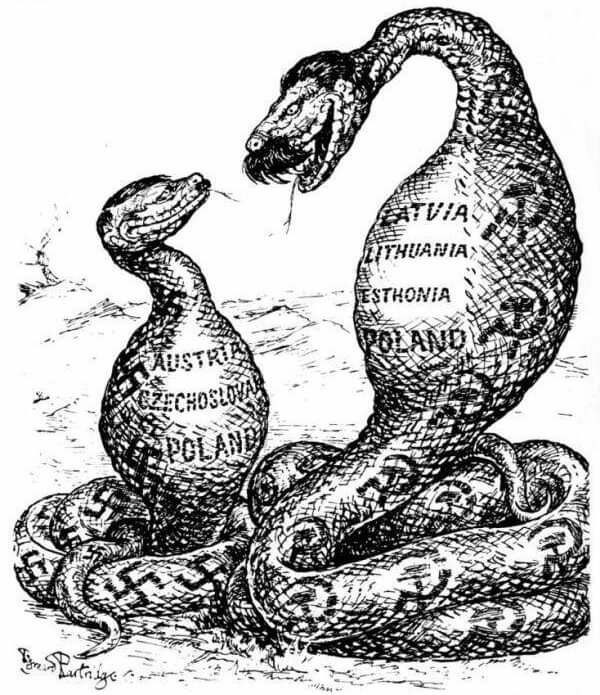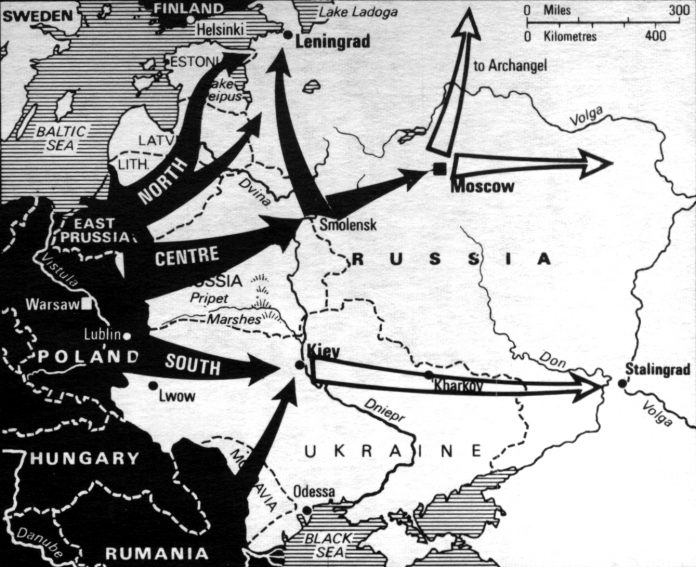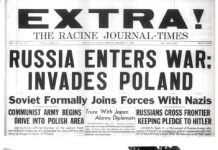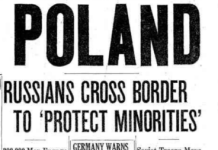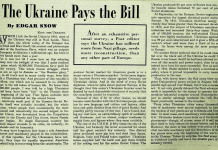Modern Russian as well as former Soviet propagandists have been trying to imply that the USSR began to form its armies only after World War Two began. But it is a lie. As a matter of fact, Moscow began forming armies in the European part of its territories in 1939 already. What is interesting, they were formed closer to the western borders – the 3rd and 4th Armies appeared in Belarus, the 5th and 6th in Ukraine, and the 7th, 8th and 9th near Finland. What for?
Harvard Professor Robert C. Tucker, a political scientist and historian in his second part of Stalin’s biography, Stalin in Power: The Revolution From Above: 1928-1941, described the important events of 1939:
“Having pursued the divisive diplomacy and observed the emergence in Europe of two potentially warring coalitions, Stalin in his party congress speech set in motion talks leading to an alignment with Berlin. He did so by professing a desire for peace and business relations with “all” interested states and disclaiming any intention of “pulling chestnuts out of the fire” for others. That raised the possibility of a negotiated neutrality which would insure Hitler against what he had to fear most: a two-front war. This, Stalin could calculate, would enable Hitler to unleash aggression and him, while remaining neutral, to take over territories in Eastern Europe on an agreed-upon basis… Five days after Stalin addressed the party congress on 10 March, Hitler seized the remainder of Czechoslovakia, setting up a protectorate over the Czech lands and a “free state” of Slovakia. This dramatic demonstration that appeasement would not satiate Hitler catalyzed change in the Anglo-French stance.”
It is after that very 18th Congress that Vyacheslav Molotov was appointed and understanding with Nazi Germany was pursued resulting in the Molotov-Ribbentrop Pact. Why did Stalin choose Molotov by the way? R.C. Tucker explains the reasons:
“On 3 May Molotov, while retaining the premiership, was appointed foreign commissar and Litvinov was dismissed from that post… The dismissal of Litvinov, who was not only Jewish but known for his pro-Western orientation, did not fail to arouse Hitler’s interest… “
From Winter War in Finland to Southern Ukraine
The 9th Army of the Soviets first appeared at the borders of Finland in 1939. In the Winter War against Finland, the 9th Army was simply a rifle corps consisting of three rifle divisions.
After the Finnish war ended, the 9th Army turned up on the Romanian frontier in southern Ukraine, where, following the Finnish pattern, it helped “liberate” the workers of Bessarabia and Bukovina at the very same time other Soviet Armies were “liberating” Estonia, Lithuania, Latvia.
“Liberation” of Bessarabia was nothing like the war with Finland – the Soviet Union pressured Romania under threat of war into withdrawing from the region. The major part of the annexed area was attached to present-day Moldova.
After the “liberation” campaign, the 9th Army, although officially disbanded, stayed in the area – its headquarters and the headquarters of the Odesa Military District merged into one entity.
Invasion, Shock and Cover Soviet Armies
The term “invasion army” was used by the Soviet experts until 1935 approximately; after that, the terms “shock army” and “cover army” were used to conceal the real purpose.
It was the strike power that made a shock army different from an ordinary army. In this case, it was a mechanized corps consisting of 1, 031 tanks which was comparable to the strike power of any German tank group. According to Viktor Suvorov, the author of ‘Icebreaker: Who Started The Second World War?‘,
“on 21 June 1941, all the Soviet armies on the German and Romanian borders, as well as the 23rd Army on the Finnish frontier, were of shock army standard. They were, from north to south, the 23rd, 8th, 11th, 3rd, 10th, 4th, 5th, 6th, 26th, 12th, 18th, and 9th. The 16th Army was then added to them.”
Three Out of the Ordinary Armies
Of the thirteen armies mentioned, three were different– the 6th and the 9th armies in Ukraine, and the 10th in Belarus.
These three armies were to have 2,350 tanks, 698 armored vehicles, over 4,000 guns and mortars and more than 250,000 soldiers and officers each (!). Also, they were to receive up to twelve heavy artillery regiments. With so many tanks, each one of them was roughly equal to one-half of the entire German Wehrmacht.
Viktor Suvorov: “If we call the German tank groups, each with between 600 and 1,000 tanks, engines of aggression, what then are we to call the 6th, 9th, and 10th Soviet Armies?”
Super Heavy Shock Army
But even out of the three heavy shock armies described above, the 9th one still stands out.
“On 21 June 1941, the 9th Army had 17 divisions in all, including two air, four tank, two motorized, two cavalry and seven rifle. At full strength, the seven corps of the 9th Army had 3,341 tanks. This was roughly the same number as the Wehrmacht had; in quality, they were superior. According to Colonel-General P. Belov (at that time he was a major-general, commander of the 2nd Cavalry Corps of the 9th Army), it was intended to give T-34 tanks even to the cavalry of this army.”
The 9th Army was also unique in having a colonel-general as its commander. Thirty other Soviet armies had major-generals and lieutenant-generals as their commanders.
Oil Fields
So, what was the most powerful army of the world doing in Western Ukraine on the border with Romania? What was its purpose?
“After the brief ‘liberation campaign’, the 9th Army disappeared again. Then, under cover of the TASS report of 13 June 1941, it turned up again in the same place. By now, though, it was no longer simply a shock invasion army. It had become a heavy shock army, and was on the way to becoming the most powerful army in the world. Its purpose can hardly have been defensive, for there were very few troops on the Romanian side of the frontier. Even if there had been, no aggressor would have delivered his main strike through Romania, for the most elementary geographical reasons. Another ‘liberation campaign’ by the 9th Army into Romania, however, could have changed the entire strategic balance in Europe and in the world. Romania was Germany’s basic source of oil. A strike at Romania would ground all Germany’s aircraft, and bring all its tanks, machines, ships, industry, and transport to a halt...
Experience shows that, after a shock army appears on the borders of a small country, an order to ‘liberate’ the neighbour’s territory is sure to follow within the month. Irrespective of how events might have unfolded had Soviet troops invaded Germany (which incidentally was just as unprepared for defence as the Soviet Union was), the outcome of the war could have been decided far from the main battlefields. Stalin was clearly counting on this…
Hitler allowed none of this to happen. A German government statement handed over to the Soviet government on the outbreak of war in the East gives the reasons for Germany’s action. One of these reasons was that Soviet troops were being concentrated unjustifiably on the frontier with Romania and that this represented a mortal danger for Germany. None of this has been invented by Goebbels’s propaganda. The 9th (heavy shock) Army had been established exclusively as an offensive army…
Three times Hero of the Soviet Union, Marshal of the Air Force A. I. Pokryshkin (then a senior lieutenant and deputy commander of a fighter squadron belonging to the 9th Army) sheds an interesting light on the 9th Army’s mood. Here is his conversation with a ‘filthy bourgeois’, whose shop had been confiscated by his ‘liberators’. The scene takes place in the spring of 1941, in ‘liberated’ Bessarabia:
– ‘Ah, Bucharest! You should see what a fine city it is.’
– ‘I’ll certainly see it sometime,’ I answered with conviction.
The shop-owner opened his eyes wide, waiting for me to go on. I had to change the subject. (A. I. Pokryshkin: Nebo voiny, Novosibirsk ZSKI, 1968, p. 10)
We have a natural reluctance to believe Hitler’s explanation that he launched Operation Barbarossa to defend Germany from a treacherous attack by Soviet troops on Bucharest and Ploesti. But the other side says the same thing; even the Soviet lieutenants knew that they would shortly be in Romania. A Soviet officer is not entitled to wander across frontiers as a tourist. In what capacity could Pokryshkin get there except as a ‘liberator‘?“
Where and when did the largest tank battle of WW2 take place? It was not Kursk >
